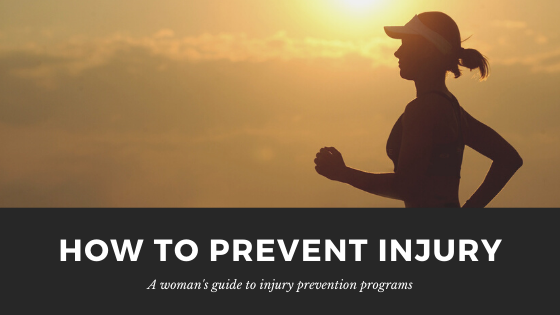
Heading out on your morning jog used to seem effortless. Your legs were strong and sure with each stride, your ankles and knees flexible and forgiving as you pounded the pavement. You didn’t have to think about each step, each turn. But times have changed. You feel wobblier, less secure in your footing and your knees are screaming at you by the end of your run. Perhaps it’s because a previous injury is haunting you or you feel anxious that your body no longer feels like it used to.
It’s hard to admit that as we age our bodies don’t function the same as they did during our high school sports days. The injuries sustained during those times can affect our performance and compromise our health in the long run. Women are especially at risk for changes in stability, strength, and flexibility which can lead to an increase in repeat injuries or an increased likelihood of injury during physical activity.
There is no reason for you to stop your morning jog or change your workouts. Studies suggest that incorporating an individualized injury prevention training program into your routine can get you back to hitting the pavement without screaming knees and aching joints.
Injury Prevention Programs
Injury prevention programs have been extensively researched and widely implemented for high school, college, and professional athletes to help fine-tune athletic performance and reduce the rates of injuries such as ACL tears, ankle sprains, and hamstring strains. However, additional research has shown that incorporating a six to eight-week injury prevention program can also decrease the reoccurrence of injuries or the likelihood of injury in women at any age.
Statistically, women are three times more likely to have an ACL injury which can increase their risk for osteoarthritis. In addition, women who suffer injuries like ACL tears or ankle sprains show an impaired function in those joints over the next five to 25 years impacting their ability to continue in the sport, workout, or daily routine that keeps them healthy.
Risk factors for injury may increase for women who have experienced a previous injury, but additional risk factors such as low or high body mass index (BMI), poor flexibility, or decreased core muscle tone may also lead to increases in injury. With a focus on improving overall performance, an injury prevention program can be individualized to focus on balance, core development, strength, mobility, body awareness, and decision-making agility. Learn more about the three main components of an injury prevention program:
Plyometrics
Plyometrics, in their simplest form, are exercises that involve jumping or an explosive movement intended to build strength, speed, and endurance. Consciously training the body to jump and land in a way that best protects your muscles and joints helps to build muscle memory and improve form when performing regular activities. Enhancing your body’s awareness regarding your foot placement when running or leg angle when making a sharp turn can help to decrease the likelihood of injury recurrence and increase the quality of any exercise. Examples of plyometric exercises utilized in the Optimal Sports Physical Therapy injury prevention program may include lunges, squats, squat jumps, or burpees.
Balance, Stabilization, and Flexibility
Improving balance, stabilization, and overall flexibility go together to enhance physical performance.These three types of exercises focus on the development of core strength to support the muscles, promote proper body alignment, improve coordination, and provide full range of motion. Examples of balance, stabilization, and flexibility exercises utilized in the Optimal Sports Physical Therapy injury prevention program may include planks, lateral lunges, and sport specific stretching.
Strength Training
Strength training, or resistance training, is targeted to both increase muscle strength and tendon flexibility. Together, the balance of strong muscles and flexible tendons decreases injury risk or injury recurrence. Strength training does not need to include hitting the weight bench at the gym. Incorporating body weight based resistance training or even light hand weights can help improve strength and increase tendon flexibility all while also improving balance and stability. Examples of strength or resistance exercises utilized in the Optimal Sports Physical Therapy injury prevention program may include push-ups, bridges, and kettlebell swings.
ACL Injuries and Reoccurrence
Many types of athletes have experienced improved function and decreased rates of injury by incorporating an injury prevention program into their training. Women make up many of the traumatic knee injuries which typically require surgical repair and have a recurrence rate between ten to twenty percent. However, ACL injury recurrence rates have declined significantly when injury prevention strategies are utilized during and post recovery.
Incorporating Neuromuscular Training (NMT)
In addition to plyometrics, balance, strengthening, and flexibility exercises, incorporating neuromuscular training (NMT) into ACL injury prevention programs have helped to see a decrease in ACL injuries from 1 in 54 to 1 in 11.
Neuromuscular ability is the capacity to send nerve signals to the muscles to contract helping to counteract an applied force like landing from a jump. These unconscious muscle activations may be as simple as your muscles tightening when you squat down to pick up a heavy item. Or in the case of an ACL injury, the nerve signals telling the muscles around the knee to contract when jumping, landing, or pushing off, giving the knee extra stability and strength.
Neuromuscular training can be easily incorporated into injury prevention programs. Utilizing the controlled environment and watchful eye of a Physical Therapist, the muscles can be trained to react and communicate for improved stability. Training not only the physical body through many common exercises but also the unconscious mind for optimal performance and outcomes.
The increase in female athletes and women leading more active lives has led to an increase in sports related injuries. Those injuries or your changing body shouldn’t stop you from reaching your optimal performance. Hit the streets for your jog with confidence that your body can support you. Know that your performance is top notch with proper alignment, strength, and flexibility.
Have you had an injury and want to get back in the game? Or, has a previous injury kept you from doing the activities you want? Start smart by incorporating an injury prevention program customized for each woman and tailored to your specific deficits with one of our Physical Therapists at Optimal Sports Physical Therapy. Call our office today to schedule a visit at (406) 502-1782 or check out our website to learn more.

